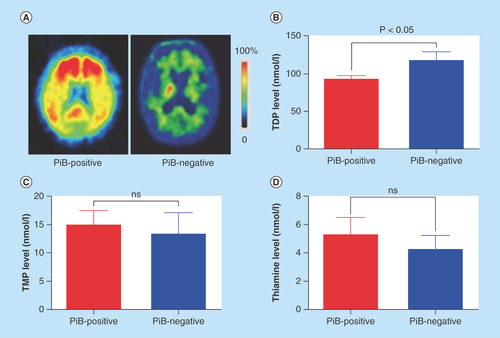Figures & data
Figure 1. Altered blood thiamine metabolites in Pittsburgh Compound-B-positive and -negative Alzheimer's disease patients clinically diagnosed.
(A) The representative images of 11C-PiB PET in PiB-positive and -negative subjects are shown. (B) Blood TDP levels were significantly reduced in PiB-positive subjects (n = 33) as compared with that of PiB-negative subjects (n = 5) (p < 0.05). (C & D) The levels of blood TMP and thiamine were not significantly different between PiB-positive subjects and PiB-negative subjects (both p > 0.05).
PiB: Pittsburgh Compound-B; TDP:Thiamine diphosphate; TMP: Thiamine monophosphate.

Figure 2. The diagnostic value of blood thiamine metabolites as a biomarker of Alzheimer’s disease examined by 11C-Pittsburgh Compound-B-positive positron emission tomography.
(A) The sensitivity and specificity of blood TDP level for the differentiation of C-Pittsburgh Compound-B (PiB)-positive patients and PiB-negative patients demonstrated by 11C-PiB positron emission tomography were 66.7% and 80.0% (p = 0.0685), respectively, when the cut-off point was set up to 99.48 nmol/l. (B) The sensitivity and specificity of γ-value for the differentiation of PiB-positive patients and PiB-negative patients demonstrated by 11C-PiB PET were 24.2 and 100.0% (p = 0.5632), respectively, when the cut-off value of γ-value was set up to 75.97. The variable γ was calculated based on the following equation: γ = (1/TDP)*([TMP + 1]∘[-0.01])*([T + 1]∘[1/6])*Age∘2 published in our previous study [Citation13].
PiB: Pittsburgh Compound-B; TDP: Thiamine diphosphate; TMP: Thiamine monophosphate.
![Figure 2. The diagnostic value of blood thiamine metabolites as a biomarker of Alzheimer’s disease examined by 11C-Pittsburgh Compound-B-positive positron emission tomography.(A) The sensitivity and specificity of blood TDP level for the differentiation of C-Pittsburgh Compound-B (PiB)-positive patients and PiB-negative patients demonstrated by 11C-PiB positron emission tomography were 66.7% and 80.0% (p = 0.0685), respectively, when the cut-off point was set up to 99.48 nmol/l. (B) The sensitivity and specificity of γ-value for the differentiation of PiB-positive patients and PiB-negative patients demonstrated by 11C-PiB PET were 24.2 and 100.0% (p = 0.5632), respectively, when the cut-off value of γ-value was set up to 75.97. The variable γ was calculated based on the following equation: γ = (1/TDP)*([TMP + 1]∘[-0.01])*([T + 1]∘[1/6])*Age∘2 published in our previous study [Citation13].PiB: Pittsburgh Compound-B; TDP: Thiamine diphosphate; TMP: Thiamine monophosphate.](/cms/asset/bf5736f4-cc9f-481a-aee5-de0a3db13e0a/ifso_a_12363964_f0002.jpg)
